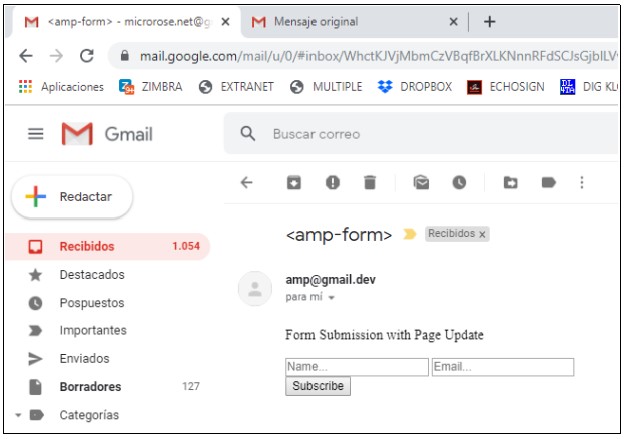
AMP stands for Accelerated Mobile Pages, a project developed by Google and other companies. The main goal of this project is to improve the mobile site load speed.
This technology is relevant to email marketers as they can embed this code in emails, improving the effectiveness of campaigns with options that were previously not allowed.
Here you can find a link with all the information and advantages of this system:
Like most Google projects, one of two things will usually happen: it will either be discontinued or become a worldwide standard. AMP was created over a year ago, and many email systems are implementing this technology. At the email level, industry giants are already accepting it as a standard, so it is now compatible with Google, Outlook, Yahoo, and other ISP.
Therefore, Mailrelay developers have decided that this is an appropriate time to support this system in our email marketing software.

· What advantages does AMP offer in email marketing?
The first advantage is that AMP is based on HTML and its own JavaScript libraries, but also with code similar to what we have on web pages. It uses almost the same tags and commands, so its implementation is relatively simple.
Also, “AMP for email” (this is what Google calls this email specific section) allows senders to include AMP components in visually appealing emails, with more advanced email display options.
This dynamic email format provides a subset of AMPHTML components for use in email messages, which allows AMP email recipients to dynamically interact with content directly in the message. Let’s look at the most relevant aspects in more detail:
► Forms in the email body
This is one of the recurring requests from thousands of customers and users: An option to create forms and request data and send email surveys without having to direct subscribers to a browser, landing page, or external platform. This would increase conversion rates as you would be avoiding intermediate steps.

► Multimedia and visual elements
From now on, you could work with videos, animations, and much more. That is, you can use many elements that, until now, were only compatible with web pages. So far, the only animation resource available to email marketers were animated GIFs, but now you have a world of possibilities when creating a newsletter!

► Search engines and web elements
Not only can we include visuals, but also any web resources we are used to managing on Internet browsers but have so far been blocked in emails for security reasons. EG. Search fields, login requests, etc.

► Dynamic real-time content from web sources or databases
This feature is similar to the RSS layout Mailrelay already has but in real-time.
The content of your campaigns can be obtained from WEB sources and SQL databases so that this dynamic information would be sent automatically in messages.
But, very importantly, the data will be obtained in real-time. So far, when the data was sent in the body of the email, it could no longer be updated.
In other words, the information the recipient will see may be updated in real-time when he opens the email. This is very useful for working with varying pricing, variable information, and news updates, custom promotions, etc.

· How does AMP work, and why is it so different?
Simply put, it’s something like a frame on a web page. That is, in the body of the email, there will be a piece of dynamic code similar to a JavaScript where we can include the information necessary to add these features to our email. Unsurprisingly, there have been several previous attempts to create a standard to update the way we read emails and modernize this communication channel.
For example, Microsoft has made a lot of progress with Silverlight.
Even if we send dynamic web code emails, scripts, etc., without this protocol on some webmail clients, it will work. The problem is that many webmails and all local clients block it because of the serious security issues this type of script could cause.
So what has changed now? Well, AMP seems to be becoming the standard system that major B2C email providers will accept. In fact, many of them already allow this code.
Gmail was the first system to support this technology, but it can also be used on Outlook and Yahoo accounts.

· How does AMP ensure security and dynamic elements will not be harmful?
Google takes several actions to ensure the security of emails with AMP content, among others:
- It requires a prior sender audit where authentication systems, portal, and privacy policy are verified.
- You will need to register in advance as an authorized sender with AMP code.
- A cache proxy will be used to eliminate dangerous or tracking elements such as cookies, etc. It will also validate the code, ensuring that it is correct.
- Emails must be sent with TLS encryption.
- There are restrictions on URL redirects.
- Google will monitor the code and will include some control parameters such as tokens, data request destination, use of JSON, etc.
- Recipients will have to enable AMP content in their email preferences.
- JavaScript is blocked except for the version of the AMP libraries.

· What do I need to do to work with AMP on my emails?
These are the steps and requirements that we must complete and fulfill to be able to send dynamic emails and work with AMP:
1-The first thing is to select an email marketing software such as Mailrelay that supports this technology by declaring content in headers and supporting sending with TLS and the authentication requirements required by Google.
IMPORTANT: AMP is only supported on Mailrelay V3; you must request to enable AMP headers in your account before sending emails with this code.
2- We have to configure SPF, DKIM, and DMARC on our sender domain, as required by ISPs that accept AMP. Mailrelay has created a tutorial with information for setting up SPF and DKIM.
Mailrelay has no specific configuration for adding the DMARC record. You will need to contact your webmaster or hosting service to enable it.
3- It is also necessary to add a link to a page with the sender domain privacy policy.
You will need to request an audit by email and register as an AMP sender with Google.
From this point on, you should read the Gmail “AMP for Email” guide for developers and senders. Once you have completed these steps, you will be able to work with this code and send emails with dynamic content, which you can SMTP over TLS through the host provided by your Mailrelay account.
Here is all the documentation needed for developers and administrators:
https://developers.google.com/gmail/ampemail
For initial testing, we can use any Gmail email account and Google’s sampling and validation system (see table).

You can test them on this Google page by enabling this option earlier in the Gmail account where you want to receive the tests. You can enable this option for receiving dynamic emails from [email protected] in Settings / General:
https://amp.gmail.dev/playground/
Here you can send sample templates or validate your own code. You can then copy and paste it to SMTP via Mailrelay on any V3 account, as long as you have contacted us asking our staff to enable AMP headers before you start working with this system.
